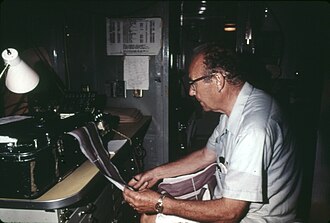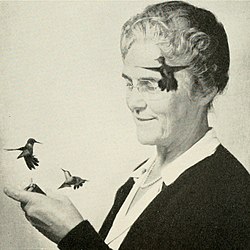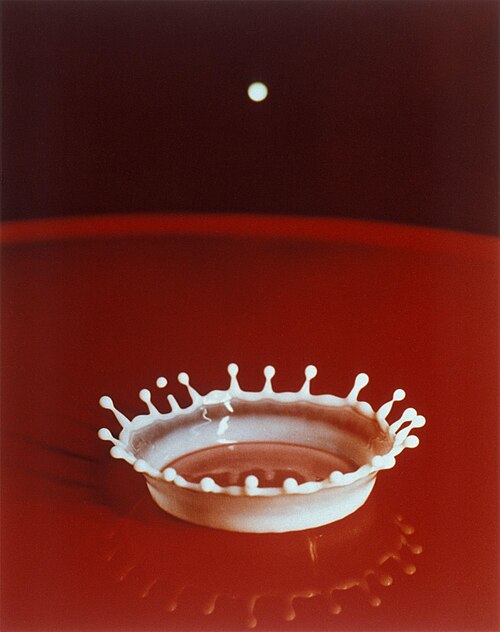
Harold “Doc” Edgerton was an engineer and photographer best known for revolutionizing strobe light and action photography. However, he also won an OSCAR®, helped discover a Civil War shipwreck, and has artwork in the Museum of Modern Art. Let’s explore his extraordinary career in honor of his birthday.
Engineer Turned Photographer
Harold Eugene Edgerton was born on April 6, 1903, in Fremont, Nebraska. His father, Frank Edgerton, served as Nebraska’s assistant attorney general. In 1925, Edgerton graduated from the University of Nebraska-Lincoln with a bachelor’s degree in electrical engineering. He continued his studies in electrical engineering at the Massachusetts Institute of Technology, earning both a master’s degree and a PhD by 1931. During this time, he also became an instructor and married Esther May Garrett.
While growing up, Edgerton learned how to take and develop photos from his uncle Ralph Edgerton, a studio photographer. However, he didn’t develop an interest in photography until he was pursuing his doctorate in engineering. At the time, he was studying a synchronous motor for his thesis and encountered a problem. He noticed that the motor spun too fast for him to observe it clearly. Soon after, he observed that the tube used to send power to the motor emitted a bright flash when the power surge reached its peak. Edgerton realized that when the flash of the light synchronized with the rotating parts of the motor, it created the illusion that the motor was standing still, making it easier to study.

Harold “Doc” Edgerton studies a sonar printout in 1973. Licensed in the public domain via Wikimedia Commons. Original photograph in the NOAA Monitor Collection.
Developing An Early Version of a Strobe Light
Edgerton was an early adopter of the stroboscope, an early version of a strobe light. The instrument consisted of either a rotating disk with slots or holes, or a light that produced brief repetitive flashes of light. Similar to modern strobe lights, it could be used to make a moving object appear slow moving or stationary. In his doctoral dissertation from 1931, Edgerton featured a high-speed motion picture of a motor in motion that he created using a mercury-arc stroboscope.
In 1932, he and his student-turned-colleague Kenneth Germeshausen released the first commercial model of a stroboscope they’d developed. That same year, Edgerton was promoted to an assistant professor at MIT. Over a span of 30 years, he applied for 45 patents for a variety of strobe and electrical engineering devices, however the patent for his stroboscope design was not awarded until 1949.
Capturing the Action
One of Edgerton’s first photography subjects was a stream of water running from a faucet. The strobe light equipment Edgerton used could flash up to 120 times a second when taking multiflash photographs. This allowed him to push boundaries and capture action photos beyond what had been capable in the past. He experimented with a wide range of subjects, such as a balloon midburst, a bullet impacting an apple, and a drop of milk splashing onto a plate. In 1936, Edgerton took photos of hummingbird expert May Rogers Webster that appeared in National Geographic. He demonstrated that it was possible to take clear photos of the birds beating their wings 60 times per second using an exposure of one hundred thousandth of a second.

Edgerton’s photo of May Rogers Webster and hummingbirds, 1936. Licensed in the public domain via Wikimedia Commons. Original photograph in the United States National Museum.
The Museum of Modern Art opened its first photography exhibit in 1937, which included one of Edgerton’s early milk-drop photographs. His quest of capturing the perfect coronet culminated in 1957, with a high-speed photograph of a drop of milk splashing onto the surface of a pan (shown below). This photo is now regarded as one of the most important photographs of all time. In 1940, he starred in the OSCAR-winning film Quicker ‘n a Wink, a documentary about his work in stroboscopic photography.

Edgerton’s “Milk Drop Coronet” photograph. Licensed in the public domain via Wikimedia Commons. Original print in the collection of the Museum of Modern Art.
Developing the Rapatronic Camera and Discovering a Shipwreck
He partnered with Germeshausen and Herbert Grier, another one of his former students, to form a consulting company called Edgerton, Germeshausen, and Grier, Inc., later shortened to EG&G. Companies in a variety of industries hired them to uncover issues with moving parts that could not be seen by the naked eye. They could shine the stroboscope light on a printing press or a watchmaking machine to make the motion of these machines appear frozen for a second, which would help share insight into any problems they were facing.
In addition, Edgerton developed the rapatronic camera, a portmanteau of rapid action electronics. It’s a high-speed camera capable of taking a still image with an exposure time of 10 nanoseconds. The camera uses two polarizing filters and a Faraday cell, mounted with their angles at 90° to each other to block all light. The Faraday cell is located between the filters, where it can change the polarization plane of the light that passes through it depending on the level of magnetic field applied. The cell acts as a shutter, energized for an extremely brief amount of time, which allows the film to be exposed.
Edgerton also worked with underwater explorers to develop specially-designed camera equipment, first on his own and then with EG&G. The company was instrumental in manufacturing side-scan sonar technology that is used to scan the ocean floor for shipwrecks. Edgerton was a part of the underseas mission to discover the Civil War shipwreck USS Monitor, which was found in 1973 off the coast of Cape Hatteras, North Carolina.
Legacy Lives On
Edgerton walked the line between artist and engineer and found many forms of success throughout his career — from winning an OSCAR® to teaching at MIT to cofounding a company. He was elected a Fellow of the American Academy of Arts and Sciences in 1956 and awarded the U.S. National Medal of Science in 1973. The International Center of Photography gave him their Infinity Award for Lifetime Achievement in 1987. Community members in his hometown of Aurora, Nebraska, built a teaching museum in his honor that opened in 1995.
In 1977, his MIT teaching career that spanned four decades culminated in his last class, a freshman seminar titled “Bird and Insect Photography”. In his honor, the university opened the Edgerton Center, a hands-on laboratory resource, and named one of the dorms after him. His wife Esther and him had three children and were together until his passing in 1990.
Further Reading
- Learn more about Edgerton’s life and view more of his artwork:
- Read about other engineers and scientists with similar experiences:
- Joseph Petzval, who cut camera exposure time from 10 minutes down to 30 seconds
- Alice Ball, who was inspired by her family of prominent photographers to pursue a career in chemistry
- Ernst Mach, who found a way to measure sound waves and sound propagation using photographic techniques
OSCAR is a registered trademark of Academy of Motion Picture Arts and Sciences Corporation.



Comments (0)